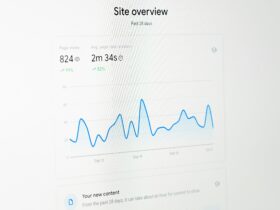
Every business owner knows the thrill of seeing website traffic numbers climb. But here’s the truth: page views and impressions don’t pay the bills.
Too many entrepreneurs obsess over vanity metrics—stats that look impressive but don’t directly impact revenue. To really grow your businyess, you need to focus on the numbers that measure performance, efficiency, and conversions.
In this guide, we’ll decode the five website metrics that actually matter and show you how to use them to fuel growth. By the end, you’ll know which dials to watch, which levers to pull, and how to turn data into dollars.
Vanity Metrics vs. Actionable Metrics
Let’s set the stage:
- Vanity metrics: Page views, followers, likes. They stroke your ego but don’t directly drive sales.
- Actionable metrics: Conversion rate, lead capture, bounce rate, customer acquisition cost. These measure how effectively your website turns traffic into revenue.
The shift from vanity to actionable metrics is what separates struggling websites from high-performing businesses.
Metric 1: Conversion Rate (The True Growth Engine)
What it is: The percentage of visitors who complete a desired action (buy, sign up, book).
Why it matters: A 2% to 4% bump in conversion rate can double your revenue without adding a single visitor.
How to improve it:
- Optimize your CTAs (clear, visible, action-oriented).
- Reduce form friction (fewer fields, better design).
- Use urgency triggers (countdowns, low stock alerts).
Pro tip: Tools like Converstar Premium make boosting conversion rates easier with built-in features like exit-intent popups, personalized offers, and scarcity banners.
Metric 2: Lead Capture Rate (Your Pipeline Health)
What it is: The percentage of visitors who share their contact info (usually email) in exchange for value.
Why it matters: Email subscribers are future customers. They’re your owned audience—safe from algorithm changes or ad price hikes.
How to improve it:
- Offer meaningful lead magnets (guides, discounts, templates).
- Use popups strategically—exit-intent or scroll-triggered.
- Segment leads at signup for more personalized nurturing.
Pro tip: With Converstar, you can create high-converting signup forms and capture leads at the perfect moment, waking up a sleeping goldmine of potential customers.
Metric 3: Bounce Rate (A Measure of First Impressions)
What it is: The percentage of visitors who leave after viewing just one page.
Why it matters: A high bounce rate often signals that your site isn’t delivering on expectations—or is too slow, confusing, or irrelevant.
How to improve it:
- Speed up load times (compress images, use caching).
- Match content to audience intent (don’t bait-and-switch).
- Improve readability (clear layout, mobile-friendly).
Action step: Track bounce rate by channel. If visitors from ads bounce more than organic, your ad targeting may be off.
Metric 4: Average Session Duration (Engagement Depth)
What it is: The average time a visitor spends on your website.
Why it matters: More time on site usually means more interest, more trust, and a higher chance of conversion.
How to improve it:
- Create content that answers real questions and solves problems.
- Add internal links to guide users deeper.
- Use engaging media like videos, infographics, or interactive elements.
Bonus tip: Personalized popups via Converstar Premium can keep visitors engaged longer by surfacing relevant offers before they leave.
Metric 5: Customer Acquisition Cost (CAC)
What it is: The total cost of acquiring one customer (ads, marketing, content creation divided by new customers).
Why it matters: You need to know if your marketing is profitable. If CAC is higher than customer lifetime value (LTV), you’re losing money.
How to improve it:
- Focus on channels with higher ROI (email, referrals, SEO).
- Optimize conversion funnels so you close more sales per dollar spent.
- Retarget visitors who didn’t convert the first time.
Tracking CAC alongside conversion rate and LTV helps you understand your true marketing efficiency.
How to Put These Metrics Into Action
Numbers without context don’t help. Here’s a simple workflow:
- Define your goals (sales, leads, bookings).
- Track the right metrics (the 5 listed above).
- Analyze weak spots (e.g., high bounce rate, low conversion).
- Hypothesize improvements (better CTAs, streamlined forms).
- Test and refine until you see measurable growth.
This data-driven approach ensures you’re not just chasing traffic but maximizing its value.
Why Tools Like Converstar Help
Once you know which metrics matter, you need ways to influence them. That’s where Converstar Premium becomes invaluable.
- Increase conversion rate with urgency popups and countdowns.
- Improve lead capture rate with scroll-triggered signup forms.
- Reduce bounce rate with personalized offers that keep people engaged.
- Extend session duration by surfacing relevant content or discounts.
- Lower CAC by squeezing more conversions from existing traffic.
Converstar bridges the gap between tracking numbers and taking action.
Final Thoughts
Your website metrics tell a story. If you focus only on vanity metrics like page views, you’ll miss the plot. But by tracking the right numbers—conversion rate, lead capture, bounce rate, session duration, and CAC—you’ll gain real insight into what drives revenue.
The best part? You don’t need to be a data scientist to make sense of them. Start simple, track consistently, and test improvements. And when you’re ready to multiply your results, integrate tools like Converstar Premium to turn insight into action















Leave a Reply